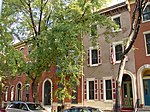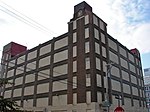Mural Arts Philadelphia
Mural Arts Philadelphia is a non-profit organization that supports the creation of public murals in Philadelphia, Pennsylvania. Founded in 1986 as Mural Arts Program, the organization was renamed in 2016. Having ushered more than 3,000 murals into being, it calls itself "the nation’s largest public art program". As of 2022, the organization says it runs 50 to 100 public art projects each year; it also works to maintain existing murals. The program was founded under the direction of the local artist Jane Golden, as part of the Philadelphia Anti-Graffiti Network, with to facilitate collaboration between professional artists and prosecuted graffiti writers to create new murals in the city. The program, which employs more than 300 artists at least part-time, is one of the largest employers of artists in Philadelphia. The program also hires more than 100 prosecuted graffiti writers every year and involves them in the creation of murals around Philadelphia. In 2006, the program employed 36 former graffiti artists as staff members on permanent payroll.It also works with community groups to educate and children in the arts and involve them in the creation of the murals; in 2006, it involved more than 300 children a year.The Mural Arts Program is responsible for the creation of the largest mural in Philadelphia, at 600 feet (180 m) in length. Titled History of Immigration, it displays settlers of different ethnicities who settled in Philadelphia over time. The program has been criticized for supporting the criminalization of graffiti and for hiring non-Philadelphia artists.
Excerpt from the Wikipedia article Mural Arts Philadelphia (License: CC BY-SA 3.0, Authors).Mural Arts Philadelphia
Mount Vernon Street, Philadelphia
Geographical coordinates (GPS) Address Nearby Places Show on map
Geographical coordinates (GPS)
| Latitude | Longitude |
|---|---|
| N 39.96531 ° | E -75.16695 ° |
Address
Thomas Eakins House
Mount Vernon Street
19130 Philadelphia
Pennsylvania, United States
Open on Google Maps










